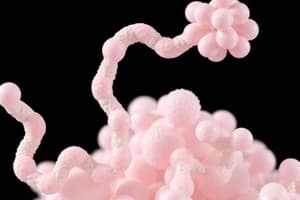Podcast
Questions and Answers
What are enzymes?
What are enzymes?
- They decrease reaction rates.
- They are a class of proteins. (correct)
- They are consumed during biochemical reactions.
- They are catalysts that increase reaction rates. (correct)
Describe the general properties of the structure of an enzyme.
Describe the general properties of the structure of an enzyme.
Enzymes are linear chains of amino acids that fold to form a three-dimensional structure with an active site.
What are the factors that will influence enzyme activity?
What are the factors that will influence enzyme activity?
Concentrations of substrates, temperature, pH, presence of activators, inhibitors, and inactivators.
How does increasing the concentration of substrate affect the enzyme reaction rate?
How does increasing the concentration of substrate affect the enzyme reaction rate?
How does increasing the concentration of enzyme affect the reaction rate?
How does increasing the concentration of enzyme affect the reaction rate?
How does temperature influence enzyme activity?
How does temperature influence enzyme activity?
How does pH influence enzyme activity?
How does pH influence enzyme activity?
What are activators, inhibitors, and inactivators?
What are activators, inhibitors, and inactivators?
How are enzymes classified?
How are enzymes classified?
Match the following enzyme classes with their descriptions:
Match the following enzyme classes with their descriptions:
What are coenzymes?
What are coenzymes?
What are prosthetic groups?
What are prosthetic groups?
What are examples of coenzymes with Oxido-reductases?
What are examples of coenzymes with Oxido-reductases?
What are examples of coenzymes with Ligases?
What are examples of coenzymes with Ligases?
What are examples of coenzymes with Transferases?
What are examples of coenzymes with Transferases?
Where are enzymes distributed?
Where are enzymes distributed?
How do we get different forms of enzymes that catalyze the same reaction?
How do we get different forms of enzymes that catalyze the same reaction?
Flashcards are hidden until you start studying
Study Notes
Enzymes Overview
- Enzymes are proteins that act as catalysts, accelerating biochemical reactions without being consumed.
Structure of Enzymes
- Enzymes are linear amino acid chains folded into a three-dimensional structure.
- The amino acid sequence dictates the enzyme's structure and its catalytic function.
- The active site includes the catalytic site and binding sites, crucial for substrate orientation and reaction activity.
Factors Influencing Enzyme Activity
- Reaction rates are affected by:
- Concentrations of substrates, products, coenzymes, and cofactors.
- Temperature and pH levels.
- Presence of activators, inhibitors, and inactivators.
Substrate Concentration Effect
- Increasing substrate concentration boosts reaction rates until enzyme saturation occurs, where further increases have no effect due to all active sites being occupied.
Enzyme Concentration Effect
- Similar to substrate concentration, increasing enzyme levels increases reaction rates until saturation limits the rate.
Temperature Influence
- Higher temperatures enhance enzyme activity until the enzyme denatures, after which activity declines.
pH Influence
- Each enzyme has an optimal pH for maximum activity; deviation can lead to denaturation, typically illustrated by a bell-shaped curve.
Activators and Inhibitors
- Activators enhance enzyme activity by binding to the enzyme.
- Inhibitors reduce activity and can be involved in allosteric regulation.
Classification of Enzymes
- Enzymes are categorized by the type of reactions they catalyze.
Enzyme Classes
- Oxido-reductases: Catalyze oxidation-reduction reactions.
- Transferases: Facilitate group transfers.
- Hydrolases: Cleave bonds with water addition.
- Lyases: Break bonds without water addition.
- Isomerases: Catalyze racemization of isomers.
- Ligases: Form bonds using energy from compounds like ATP.
Coenzymes and Prosthetic Groups
- Coenzymes: Nonprotein compounds essential for enzyme functionality, often reversible.
- Prosthetic groups: Nonprotein elements permanently attached to proteins, functioning as irreversibly bound coenzymes.
Coenzymes in Specific Reactions
- Oxido-reductases:
- NAD+/NADH, NADP+/NADPH, FAD/FADH2, Cu2+/Cu+.
- Ligases:
- ATP, Biotin for enzymes like Pyruvate Carboxylase.
- Transferases:
- ATP/ADP for kinases, Pyridoxal phosphate for aminotransferases.
Enzyme Distribution
- Enzymes are localized within cells and tissues based on reaction requirements, e.g., hydrolases in lysosomes, peroxidases in peroxisomes, and DNA polymerases in nuclei.
Variability in Enzymes
- Enzymes that catalyze the same reaction can exist in different forms, often synthesized from pro-enzymes.
Studying That Suits You
Use AI to generate personalized quizzes and flashcards to suit your learning preferences.




